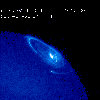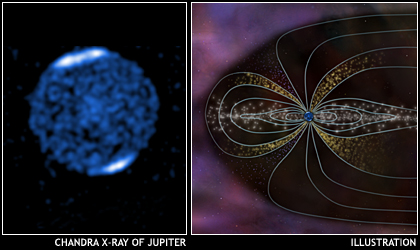Chandra Probes High-Voltage Auroras On Jupiter
Jupiter shows intense X-ray emission associated with auroras in its polar regions (Chandra image on left). Extended monitoring by Chandra showed that the auroral X-rays are caused by highly charged particles crashing into the atmosphere above Jupiter's poles.
The charged particles were primarily ions of oxygen and other elements that were stripped of most of their electrons, which implies that the ions were accelerated to high energies in a multimillion-volt environment above the planet's poles. Such high voltages indicate that the cause of many of Jupiter's auroras is different from auroras produced on Earth or Saturn.
The accompanying schematic illustrates how Jupiter's unusually frequent and spectacular auroral activity is produced. Jupiter's strong, rapidly rotating magnetic field (light blue lines) generates strong electric fields in the space around the planet. Particles (white dots) from Jupiter's volcanically active moon, Io, drift outward to create a huge reservoir of electrons and ions. These charged particles, trapped in Jupiter's magnetic field, are continually being accelerated (gold particles) down into the atmosphere above the polar regions, so auroras are almost always active on Jupiter.
Electric voltages of about 10 million volts, and currents of 10 million amps - a hundred times greater than the most powerful lightning bolts - are required to explain the auroras, which are a thousand times more powerful than those on Earth.
On Earth, auroras are triggered by solar storms of energetic particles, which disturb Earth's magnetic field. As shown by the swept-back appearance in the illustration, gusts of particles from the Sun also distort Jupiter's magnetic field, and on occasion produce auroras.
|
||||||||||||||||||||||||||
On the left panel in this graphic is a Chandra X-ray Observatory image of Jupiter. This part of the image is reminiscent of a luminous light blue circular shape with a fuzzy texture and bright white caps at the north and south poles, creating a shimmering image of the planet. Extended monitoring by Chandra showed that the auroral X-rays are caused by highly charged particles crashing into the atmosphere above Jupiter's poles. The accompanying artist's concept on the right illustrates how Jupiter's unusually frequent and spectacular auroral activity is produced. The illustration looks like a line drawing, partially filled with gold and white dots, of an octopus swimming on its side. Jupiter's strong, rapidly rotating magnetic field (the light lines) generates strong electric fields in the space around the planet. Particles (white dots in the middle area) from Jupiter's volcanically active moon, Io, drift outward to create a huge reservoir of electrons and ions. These charged particles, trapped in Jupiter's magnetic field, are continually being accelerated (gold particles around the perimeter) down into the atmosphere above the polar regions, so auroras are almost always active on Jupiter.





